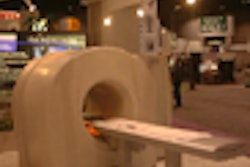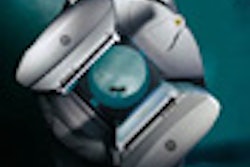FDG-PET could replace the more cumbersome combination of leukocyte/marrow scintigraphy in order to detect chronic orthopedic infections such as osteomyelitis, according to Belgian researchers.
While the bone/white blood cell scans are considered the standard, noninvasive technique for diagnosing these infections, they are far from ideal, said Dr. Frederic de Winter at the June Society of Nuclear Medicine conference in St. Louis. Because of low resolution, the two standard scans cannot always differentiate between soft tissue infection and bone infection. In addition, the presence of bone marrow in the central skeleton can cause problems because of high bone marrow uptake, he said.
In this retrospective study conducted at Ghent University Hospital, 32 patients were evaluated with fluorine-18 fluorodeoxyglucose PET and leukocyte/marrow scintigraphy. Surgical or clinical follow-up information was available on all the patients. Out of the 32, there were 34 cases of suspected infectious problems in the central skeleton (Group A) and 17 instances of infection in the peripheral skeleton (Group B).
FDG-PET was performed on a Siemens ECAT 951/31 scanner after an injection of 370 MBq FDG within one week of the patient presenting at the hospital. Bone/white blood cell scans were performed four hours after tracer injection.
There were five positive cases of infection in Group A and seven in Group B, de Winter said. Two readers reported the same results for the FDG-PET scans in the skeleton group with a sensitivity of 100%, a specificity of 92%, and an accuracy of 94%. In Group B, the sensitivity was 100%, the specificity was 90%, and the accuracy was 94%, according to the results of both readers.
For the bone/white blood cell scans, the sensitivity was 33%, the specificity was 91%, and the accuracy was 71% for Group A, based on the first reader's report. For the second reader, there was 17% sensitivity, 100% specificity, and 76% accuracy. In Group B, both readers' results yielded a sensitivity of 86%, a specificity of 90%, and an accuracy of 88%.
In one case, the FDG-PET exam was able to rule out chronic infection while the other scans could not, de Winter said. The patient presented with acute neck pain. The bone/white blood cell scans were inconclusive, as were x-rays and MRI exams. The FDG-PET scan was normal, and, a year later, the woman had no signs of a chronic infection, he said.
While both FDG-PET and bone/white blood scans were suitable for imaging the peripheral skeleton, FDG-PET's higher resolution in the central skeleton gives it an edge over the standard techniques, de Winter concluded.
The results from a Swiss study reached the same conclusion. Clinicians at University Hospital in Zurich used FDG-PET to diagnosis chronic osteomyelitis. Several imaging exams were done, including MRI, antigranulocyte antibody scintigraphy, and FDG-PET. The infection of the fibular transplant was demonstrated clearly by PET but not by the other methods, the authors wrote (European Radiology, May 2000, Vol. 10:5, pp.855-858).
However, FDG-PET may fall short when trying to differentiate inflammation from infection, de Winter said. In a study out of the University of Pennsylvania, FDG-PET was effective for ruling out osteomyelitis, but these positive results could be caused by either infection or inflammation in the bone or surrounding soft tissue (Clinical Nuclear Medicine, Apr. 2000, Vol. 25, pp. 281-284).
By Shalmali Pal
AuntMinnie.com staff writer
June 19, 2000
Related Reading:
FDG-PET seeks to make connection between prosthetic joints and infection, June 5, 2000
Let AuntMinnie.com know what you think about this story.
Copyright © 2000 AuntMinnie.com


















